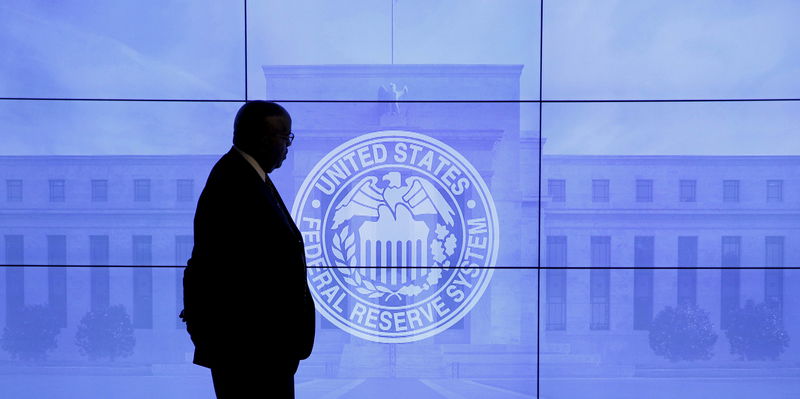(Bloomberg) -- There’s too much momentum and too little debt for rising interest rates to derail the U.S. economic expansion.
That’s the conclusion from economists arguing that this time really is different for an American economy facing the prospect of higher interest rates. Unlike a decade ago, corporate and household balance sheets are healthy enough to withstand likely increases in benchmark Federal Reserve rates, they argue.
Although credit card delinquencies have edged up, the total amount U.S. households spend on debt servicing as a proportion of gross domestic product is about 10 percent, near the lowest in at least 40 years. Meantime, businesses’ net interest expense as a share of earnings before interest and taxes stands below 15 percent, well shy of its dot-com and housing bubble cyclical peaks.
The main reason to be sanguine is that in pushing borrowing costs up, investors are merely pricing in signs of solid economic momentum, underscored by the lowest unemployment rate since 2000 and the fastest-expanding manufacturing sector in nearly 14 years. Such strength means few see higher bond yields derailing the expansion any time soon.
"You can’t think of yields in isolation -- and this episode of rising rates has come along with higher nominal growth," said Mayank Seksaria, head of macro strategy and research at Macro Risk Advisors. “For risk assets, this has less negative implications than an alternative case in which the spread between rates and growth narrows, or is expected to narrow."
Even then, Gennadiy Goldberg, an interest-rate strategist at TD Securities in New York, said a much smaller proportion of household debt adjusts with market rates than in the pre-crisis years, reducing the threat to homeowners of higher market rates.
“There are, in particular, fewer floating rate mortgages,” said Goldberg.
The proportion of U.S. first-lien mortgages with floating rates fell to 9 percent in 2017, the lowest level in data going back to 2000, according to Black Knight Inc. in Jacksonville, Florida. That’s been falling steadily since 2006, just before the financial crisis, when it peaked at 25 percent.
At Bank of America Merrill Lynch (NYSE:BAC), Michelle Meyer, head of U.S. economics, said the 30-year fixed mortgage rate would have to rise more than 100 basis points from current levels for housing affordability to return to its pre-bubble average, even assuming that median home prices also rise by 1.5 percentage points more than median family income. The rate ticked up to 4.46 percent last week, the highest since January 2014.
Higher rates will also be easily absorbed if the accelerating economy also spurs wages, according to Tom Simons, senior economist at Jefferies LLC in New York.
“If all the positives in the economy factor into real wage growth, then consumers, after a period of time, won’t be as concerned about these rising interest rates,” said Simons, who noted rates are also rising from low levels.
As for companies, they have “been pretty diligent about locking in low rates for an extended period," said Meyer. At the same time, the earnings per share of S&P 500 companies are expected to advance more than double-digits this year thanks to a combination of decreased taxes and firmer activity.
"There’s no immediate vulnerability for the economy in 2018 -- you’re not going to bring it down with the interest rates effect," said Srinivas Thiruvadanthai, research director at the Jerome Levy Forecasting Center. That “means that interest rates will keep going up, and maybe 2019 will be more of a problem," he said.
In assessing the potential for rising rates to adversely affect economic activity, the strategist is closely monitoring credit spreads, the flow of capital to emerging markets, and the value of the dollar. At this juncture, he said, none of these are flashing red.
"Insofar as corporate profits are concerned, they’re kicking up from 2016 to 2017, and 2018 is looking strong," said Thiruvadanthai. "That’s not a very late-cycle phenomenon."
Typically, corporate profit growth had been waning as Federal Reserve tightening cycles progressed; from a firm’s perspective, rising rates added to the impetus to forgo boosting production.
Even stressed parts of the credit market could benefit from a faster-growing, offsetting higher borrowing costs.
“The junk bond market would probably lose some favor” amid rising rates, said John Vail, chief global strategist at Nikko Asset Management in New York. “But would it entail so much extra costs that issuers would not benefit from a cyclical recovery in the economy? I’d say it’s at least a wash, if not better.”
To Vail, the one thing he worries could upset that rosy scenario is bond market volatility, an extended period of which, he said, could disrupt both bonds and equities. And what’s most likely to trigger that would be a mistake in communication by new Fed Chairman Jerome Powell, especially if the central bank picks up the pace of tightening.
“If Powell and others in the core think four rate hikes is very possible this year, they should be communicating that and doing so gradually,” he said.
